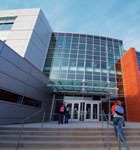A number of universities throughout the country have adopted sustainable building initiatives that center on certifying new construction projects through the LEED-NC rating system, but few are equally committed to getting their existing building stock LEED-EB certified. Western Michigan University (WMU) is one of these rare institutions.

Certification of existing buildings, such as the Chemistry Building, has been a priority for Western Michigan University.
Home to the first LEED-EB Gold-certified building in higher education, the university currently has five additional existing buildings that have been submitted for certification. Also, the USGBC has asked the school to participate in its Portfolio Partners Program (P3), a pilot program focused on the performance of existing buildings within large real-estate portfolios. If that weren’t enough, the institution also is currently constructing four LEED-certified on-campus apartments and a new $60 million facility, Sangren Hall, which is targeting LEED Gold. According to John Dunn, the president of the university and the person credited with its green vision, “[At Western Michigan], sustainability is not a new trend; it’s a culture.”
Construction of the four-story, 200,000-square-foot Sangren Hall began in fall 2010, says Peter Strazdas, associate vice president of facilities management, and structural framework is now complete. A primary reason the new hall will achieve LEED Gold status is because it’s built to consume 25 percent less energy than the existing facility, 20 percent of which was demolished prior to construction. The energy reduction will be accomplished through the use of daylighting, specific materials that provide better glazing and insulation, mechanical systems and strategies for nighttime setbacks, and sophisticated sensor technology. Strazdas says the HVAC systems within the hall’s large rooms will be controlled by sensors that are triggered only when multiple people are present—unlike a motion or occupancy sensor that can be triggered by a lone nighttime custodian.
Slated for completion in fall 2012 and built by the Miller-Davis Company, the facility will attain additional LEED checklist points by retaining all storm water on-site during construction, establishing electric-vehicle charging stations nearby, and installing green roofs that feature a variety of plants. “We’ve made a commitment to have all new projects be LEED certified and meet the minimal level of Silver,” Strazdas says.

Completed in 2007, the copper-roofed Richmond Center for Visual Arts is a sweeping, 44,000-square-foot building that houses the university's Frostic School of Art and a variety of public exhibition spaces.
While the university is committed to specific LEED ratings for new facilities, it still places equal or greater focus on existing-building certification. “Other campuses have plenty of NC—but not that many EBs,” Strazdas says. “Our institution is going on a different path with certification. Instead of following the pack, we are taking a dual track.” The main reasons for this are because WMU has a significantly larger percentage of existing buildings on campus and because it has more to gain from focusing on existing-building certification. “If you’re not spending money on new-building construction, it’s time to look to the existing structures; you’ll see more energy savings,” Strazdas says.
The LEED Existing Buildings Operations and Maintenance (EBOM) rating system is considered more involved and difficult than the certification process for new construction because it addresses the deployment of whole-building cleaning and maintenance issues across an entire campus. These issues include chemical use, recycling programs, exterior maintenance programs, and systems upgrades that maximize operational efficiency while minimizing environmental impacts.
“The bigger story is how we took one building and applied all those practices across the entire campus,” Strazdas says, adding that the process involved educating several hundred custodians and maintenance and grounds people who care for the university’s 150 buildings and its surrounding landscape. Now, as the school further involves itself in the LEED-EB program by participating in the P3 pilot program, WMU will continue it’s two-pronged approach toward sustainability, furthering the culture it has already fostered.

